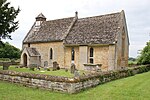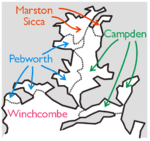Hayles Abbey Halt railway station
Accuracy disputes from March 2022Disused railway stations in GloucestershireFormer Great Western Railway stationsHeritage railway stations in GloucestershirePages with no open date in Infobox station ... and 4 more
Railway stations in Great Britain closed in 1960Railway stations in Great Britain opened in 1928Stanway, GloucestershireUse British English from December 2017

Hayles Abbey Halt railway station is a halt opened by the Great Western Railway on the Honeybourne Line from Honeybourne to Cheltenham which served the hamlet of Hailes in Gloucestershire, as well as the nearby Hailes Abbey, between 1928 and 1960. The line through the site of the station was reinstated in 1985 and opened in 1987 by the Gloucestershire Warwickshire Railway, although for many years no new halt was provided. The halt was eventually reopened on 5 June 2017 after being rebuilt by volunteers. Unlike the original, however, it only has a single platform. It lies between Toddington and Winchcombe stations.
Excerpt from the Wikipedia article Hayles Abbey Halt railway station (License: CC BY-SA 3.0, Authors, Images).Hayles Abbey Halt railway station
Salter's Lane, Tewkesbury Stanway
Geographical coordinates (GPS) Address Website External links Nearby Places Show on map
Geographical coordinates (GPS)
| Latitude | Longitude |
|---|---|
| N 51.97521 ° | E -1.93314 ° |
Address
Hayles Abbey Halt
Salter's Lane
GL54 5PJ Tewkesbury, Stanway
England, United Kingdom
Open on Google Maps










